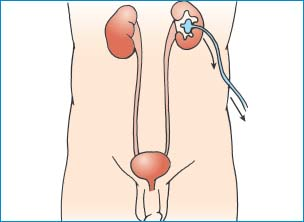Nephrostomy and Cystostomy Tube Dressing Changes
Two urinary diversion techniques—nephrostomy and cystostomy—ensure temporary or permanent drainage from the kidneys or bladder and help prevent urinary tract infection or kidney failure. (See Urinary diversion techniques, page 512.)
A nephrostomy tube drains urine directly from a kidney when a disorder inhibits the normal flow of urine. The tube is usually placed percutaneously, although sometimes it’s surgically inserted through the renal cortex and medulla into the renal pelvis from a lateral flank incision. Tube placement is usually performed because of obstructive problems, such as ureteral or ureteropelvic junction calculi or tumors. Diverting urine with a nephrostomy tube also allows kidney tissue damaged from obstructive disease to heal.
A cystostomy tube drains urine from the bladder, diverting it from the urethra. This type of tube is used after certain gynecologic procedures, bladder surgery, prostatectomy, severe urethral strictures, or traumatic injury. The tube is inserted into the bladder approximately 2″ (5 cm) above the pubic symphysis and may be used alone or in addition to an indwelling urethral catheter.
Equipment
Antiseptic swabs ▪ linen-saver pad ▪ paper bag ▪ gloves ▪ sterile gloves ▪ precut 4″ × 4″ sterile drain dressings or transparent semipermeable dressings ▪ hypoallergenic adhesive tape.
Preparation of Equipment
Gather the equipment at the patient’s bedside. Open the skin cleaning swabs, the 4″ × 4″ sterile drain dressings, and sterile gloves. Open the paper bag and place it away from the other equipment to avoid contaminating the sterile field.
Urinary Diversion Techniques
A cystostomy or a nephrostomy can be used to create a permanent diversion, to relieve obstruction from an inoperable tumor, or to provide an outlet for urine after cystectomy. A temporary diversion can relieve obstruction from a calculus or ureteral edema.
In a cystostomy, a catheter is inserted percutaneously through the suprapubic area into the bladder. In a nephrostomy, a catheter is inserted percutaneously through the flank into the renal pelvis.
Implementation
Verify the doctor’s order.
Confirm the patient’s identity using at least two patient identifiers according to your facility’s policy.1
Provide privacy.
Explain the procedure to the patient. Answer all questions to decrease anxiety and increase cooperation.

Stay updated, free articles. Join our Telegram channel

Full access? Get Clinical Tree


Get Clinical Tree app for offline access


